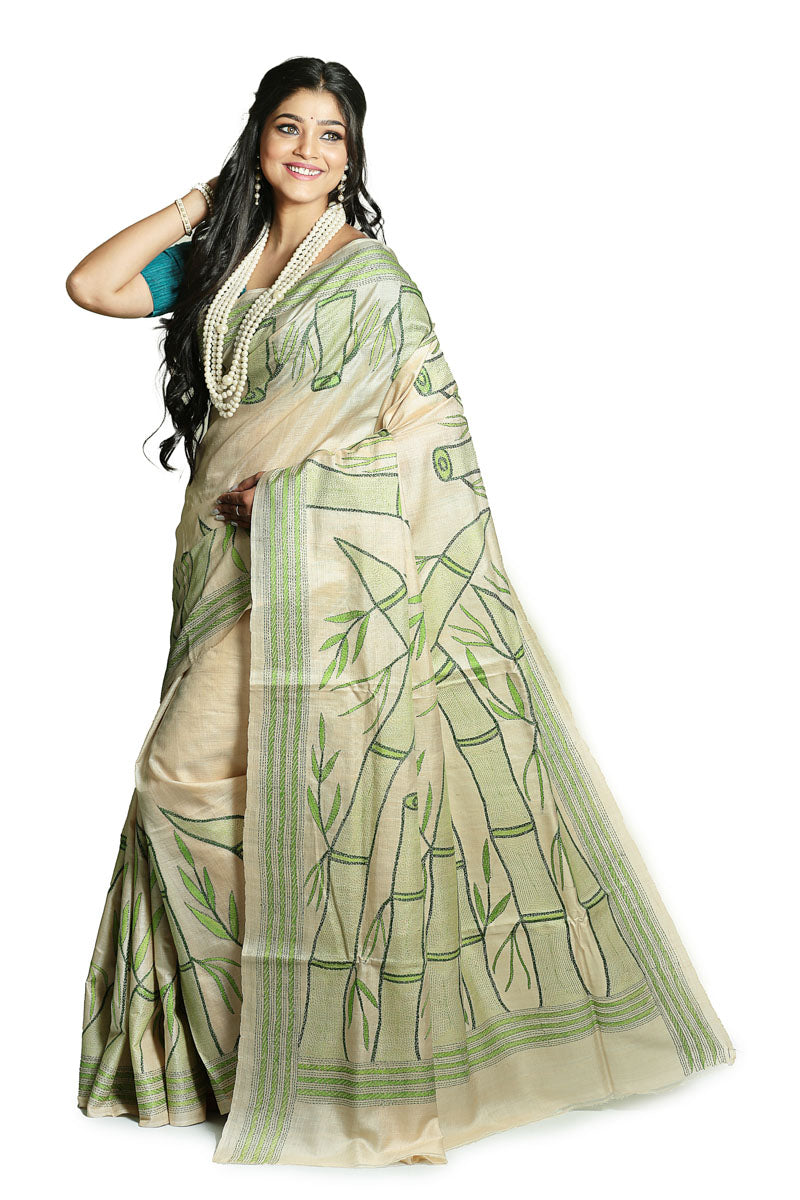Take Care of Your Handloom Sarees and Keep them Looking Fresh!

A handloom saree, as the name suggests, is one that is woven by hand in shuttle-pit looms. There was a time in recent history when power looms had all but taken over the Bengali saree market. Thanks to saree enthusiasts, native designers, and the Fashion Council of India, handloom sarees like muslin saree, tant silk sarees, and maheshwari silk sarees have had the resuscitation of the century.
However, as alluring as the rugged appeal of a handloom saree is, they require a greater amount of maintenance and care as compared to their power loom cousins. These sarees are often emotional investments and family heirlooms, it is only fair that you take care of them the right way. (update intro and add seo keyword)
Recommended: The History Of Katha Embroidery: From Ancient India To Modern Times
How to Wash Hand-Woven Bengali Sarees?
Hand-woven Bengali sarees are delicate and need special care when washing to maintain their beauty and longevity. Before washing, it is important to check the saree's fabric and colorfastness. If the saree is silk, it should be dry-cleaned only. If it is cotton or a blend of cotton and silk, it can be washed by hand.
You can definitely use soap to wash a handloom saree but there is a secret technique that you should use to lock in the dyes. Soak the saree in salt water for some time before rinsing it with cold water. Never leave the saree in water overnight lest you want to risk fading and discoloration.
Buy a good quality, mild detergent to clean your handloom saree. Stay away from harsh soaps, bleach, and stain removers (no matter gentle they claim to be). Using cold water prevents the dye from running. You should also ditch machine washing for handloom sarees. Rinse the saree thoroughly with cold water until all soap residues are removed. Squeeze out excess water, and do not wring or twist the fabric as it can cause damage to the fabric. Hang the saree on a hanger or drying rack in a shaded area away from direct sunlight to air dry.
Must Read: Modern Bengali Saree Draping Style You Should Know
Removing a Stain
The longer you let a stain sit, the harder it is going to be to get rid of it. If you spill oil on your saree, dump a sizable amount of talcum powder on it and wait for it to soak the oil. Leave it for 10-15 minutes for good measure, then rub it off gently and wash it with cold water.
Some people suggest cotton dipped in petrol to remove beverage or curry stains. But if you ask us, that is impractical for two reasons - one, it may be hard to get your hands on petrol, and two, using raw petrol on your saree might make matters worse. Instead, we suggest you take your saree to the dry cleaners at the earliest.
How to Dry a Handloom Saree?
Dry the saree in the shade and avoid direct sunlight at all costs. Under no circumstances should you squeeze the delicate fabric to get the water out; it may cause permanent creases. Letting it air dry is the best way to go. But if you need a faster way to get rid of the extra water, you can always try soaking it up with an absorbent towel or tissue. Lay the saree over a flat surface for better drying but avoid painted and rusted surfaces.
How to Iron Your Saree?
Once your handloom saree has dried, you will need to iron the saree. Always use the iron in the lowest heat setting to preserve the shine of the yarn. Do not spray water over the cloth before ironing. It is also highly suggested that you use an ironing board during pressing to avoid unintentional creasing.
What Must Be Done To Keep Bengali Sarees Looking Good for Longer?
Bengali sarees are timeless pieces of clothing that need special attention and care to maintain their longevity. Always check the saree label for washing instructions and use a gentle detergent or fabric softener.
- Before you shelf your saree for safekeeping, make sure that it is completely dry.
- You should also keep the saree wrapped in a muslin cloth to keep away dust and direct sunlight.
- As with any other saree, handloom sarees too should be stored vertically, hanging on plastic hangers. Plastic is essential to avoid rust.
- Reach for neem leaves instead of naphthalene balls.
- Another hack is to refold the saree every once in a while, such that permanent creases do not set in.
- Do not apply deodorant or perfume directly to the saree. (update conclusion)
Embrace the Timeless Elegance with Banglarsare
Bengali sarees today have a huge place for the art of handloom weaving. Banglar saree brings you sarees from all corners of Bengal and India. We take pride in providing the finest handloom fabric for all occasions. Our collection of handloom sarees is carefully curated to offer you the most elegant and high-quality pieces. Each saree is a testament to the rich culture and tradition of Bengal. Every fabric at Banglarsare showcases intricate handwoven designs and exquisite craftsmanship. With our commitment to quality and customer satisfaction, you can trust that our sarees will exceed your expectations. It will surely add a touch of elegance and grace to any occasion. Check out our festive collection at up to 65% off on our website!






